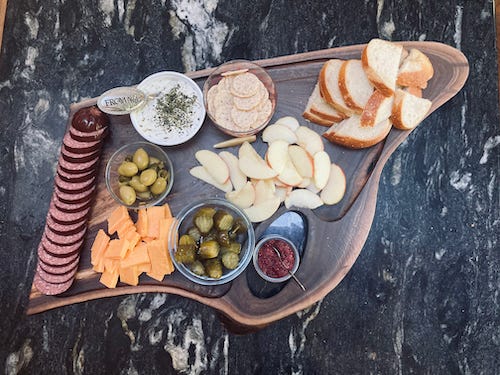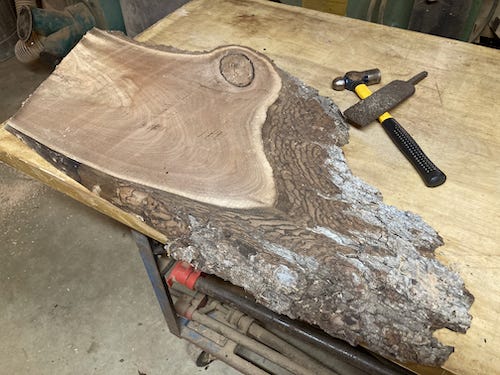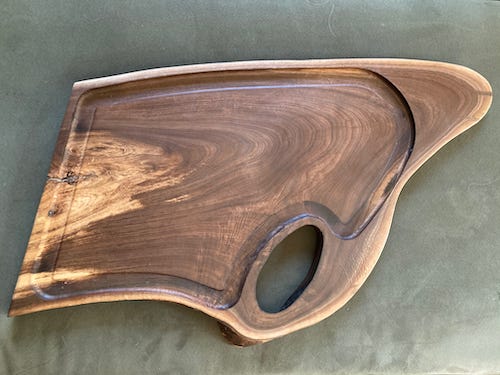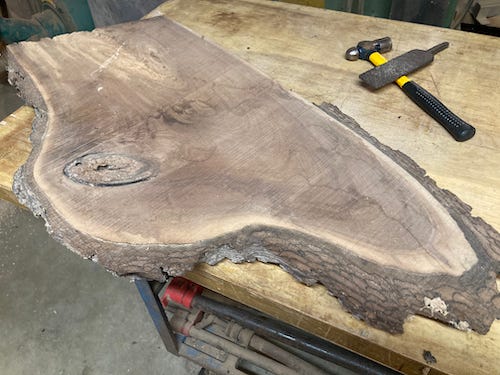Old growth with a little sap wood: A slab becomes a charcuterie board
Charcuterie board | Writing project
Greetings and salutations—
I’ve been working on a big writing project and digging through old newsletters, such as the one I’m sharing today from 2022. Re-reading these older essays brings to mind (1) who I used to be, and (2) an interview I heard awhile back with author Kiese Laymon (just looked it up, it’s from an episode of the Ezra Klein show that Tressie McMillan Cottom hosted in November 2021). I don’t remember much about the conversation, just that part of it focused on revision. I remember appreciating how boldly Laymon approached revision.
It may not surprise you to learn that it can be quite tricky to revise a completed cabinet. At several points along the way of building anything, you cross a no-return zone wherein any wrong cut will irrevocably mess up the rest of what you’re trying to do. It’s hard to revise a board you’ve cut to 2 11/16” wide to 2 3/4” wide.
Part of why I write (among many reasons) is that it does offer more flexibility in this regard. A word can be swapped with another, entire sentences or paragraphs removed or relocated, no harm, no foul, no need for an arsenal of curse words to come to the rescue.
Even an essay that has already been shared. So I thought that with today’s essay, I’d tinker with it and tell this story of a charcuterie board from my 2025 gaze.
Essay is below—I hope the next couple weeks give you a chance at revision, a chance to explore returning and reshaping something from your own past. ❤️
A slab becomes a charcuterie board, redux
Where does the spark to build come from? Be it a piece of furniture or a relationship?
Sometimes it’s from what you stumble across—the first charcuterie board I ever made came from discovering a hunk of black walnut in the burn pile, a hulking thing with a flame-shaped deformation of white wood eating up the middle.
That heavy end slab of walnut now sits polished and loved in our kitchen, transformed into a charcuterie board, a social gathering fixture boasting tomato stains and the aural rings from sweating glasses.
In 2022, a few years into woodworking, but before I was confident enough to call myself a woodworker when I met new people, that piece of black walnut was covered in sawdust keeping company with other oddly shaped scraps next to Dad’s sawmill.
That pile, taking up about the space of a small bedroom, filled with myriad species of Minnesota hardwoods, some long and leaning against the sheet metal wall, others small and buried in the mix, all of them dusty from the sawmill’s work—that area remains one of my favorite places on this earth. Its magnetic pull calls to the inquisitive raccoon living in the back of my mind that wants to dive into someone else’s discards.
Most of what my dad builds is cabinetry—think arts and crafts style kitchen cabinets, built-in bookshelves, side tables, and the like. He’d never made a charcuterie board before and neither had I. Making this was a learning experience for us both, which is one of the best parts of woodworking. You can spend years at this craft developing a high level of skill and expertise, yet there is always more to learn and try.
The idea for the board came from my sister, who wondered if, when I was picking through all those delightful scraps, I could keep an eye out for a visually interesting piece that might make a nice board. We talked about the features she wanted and I thought to myself, how hard could that be?
More attempts than not to make something beautiful (and useful) fail to become reality in my work. It takes twin skills that some days I simply lack: a seeing-within-seeing ability and patient confidence. Sometimes I can easily imagine what a piece of wood could become, holding both what is and what could be simultaneously, being realistic about the former and optimistic about the latter.
However, as much as I want a project to turn out just as I’ve imagined, such control has to be surrendered during the process. Nothing I create in the real world will be as wonderful as that which resides exclusively in my mind.
“Any attempt to bring our ideas into concrete reality must inevitably fall short of our dreams, no matter how brilliantly we succeed in carrying things off—because reality, unlike fantasy, is a realm in which we don’t have limitless control, and can’t hope to meet our perfectionist standards,” writes Oliver Burkeman in Four Thousand Weeks.
These words bring to mind the spectral army that lives in my brain, ravaging the creative bits for its own consumption—
I was waiting to be a woodworker until I had the time.
Waiting until I had more equipment.
Til I could take a class or learn from someone more experienced.
Waiting to make a business until I had more skill.
To write until I could shape my words better.
Waiting.
“Fixing to do,” instead of just doing, however imperfectly and messily the result. However much it would hurt to fall short of my own expectations.
“Since every real-world choice about how to live entails the loss of countless alternative ways of living, there’s no reason to procrastinate, or to resist making commitments, in the anxious hope that you might somehow be able to avoid those losses,” Burkeman writes. “Loss is a given. That ship has sailed—and what a relief.”
We took the slab, roughly planed on both sides with bark on the back and a five-inch knot running through, and cleaned it up. Scraped all the bark off, smoothed out each side creating a flat surface, removed all the material in the knot. Using a router, we cleared out the wood in the middle of the board, making a 1/2” deep center with a 3/4” lip just about all around.
And though the end result turned out well enough to become beloved in our house and to use with regularity, holding the reality in my hands, I can tick off the places where it falls short of my imagination.
Yet it is brought to life, and through it I see more clearly that the desire for absolute control will only ever be a limiting force in my work—a screw-tightening rigidity that would break me before ever granting creative grace.
No more waiting. Just accepting the loss that was only imaginary to begin with, and moving on, twitchy raccoon fingers ready to sift through the pile for the next project.










